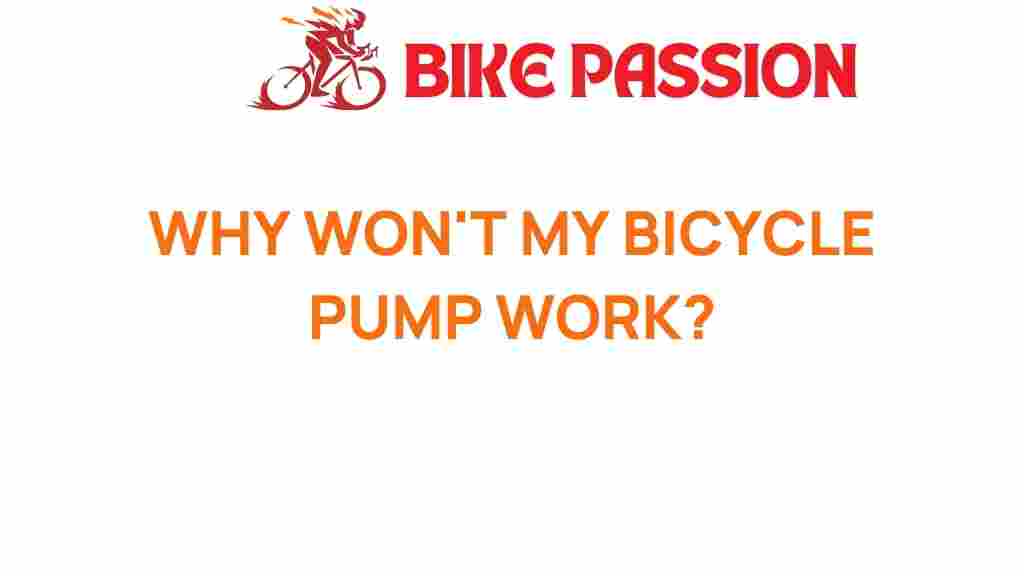The Mystery of the Bicycle Pump: Why It Won’t Work When You Need It
When you’re gearing up for a cycling adventure, the last thing you want is to discover that your bicycle pump is not functioning as it should. A reliable pump is an essential piece of cycling gear that can save you from a flat tire and keep you moving. But what happens when you find yourself facing inflation issues right when you need it the most?
This article dives into the common problems associated with bicycle pumps, offering troubleshooting tips and maintenance advice to ensure you’re never left stranded. Let’s unravel the mystery and get your bicycle pump back in working order!
Understanding Your Bicycle Pump
Bicycle pumps come in various types, including floor pumps, hand pumps, and CO2 inflators. Each has its unique design and functionality. Understanding how your pump works is the first step in troubleshooting and resolving any issues.
- Floor Pumps: Ideal for home use; they provide high pressure with less effort.
- Hand Pumps: Portable and lightweight, these are great for on-the-go inflation.
- CO2 Inflators: Quick and compact, perfect for emergency situations but require CO2 cartridges.
Common Problems with Bicycle Pumps
Even the best bicycle pumps can run into problems. Here are some of the most frequent issues you might encounter:
- Loss of Pressure: After inflation, the tire may still feel flat.
- Blocked Valve: Debris can clog the valve, preventing air from entering.
- Damaged Hose: Cracks or holes in the hose can lead to air leaks.
- Incompatible Valve Types: Not all pumps work with every valve type (Schrader vs. Presta).
- Seals and Gaskets: Worn or damaged seals can cause air loss during inflation.
Troubleshooting Your Bicycle Pump
If you find yourself in a situation where your bicycle pump isn’t working, follow these troubleshooting steps to identify and resolve the issue:
Step 1: Check the Connections
Ensure that the pump head is securely attached to the valve. A loose connection can prevent air from flowing properly. Here’s how to check:
- Remove the pump head from the tire valve.
- Inspect the valve for dirt or debris.
- Reattach the pump head, ensuring a snug fit.
Step 2: Inspect the Hose
Examine the pump hose for any visible damage. If you see cracks or holes, the hose may need replacing. Follow these steps:
- Look for any signs of wear or tear.
- Test the hose by covering one end and trying to blow air through it.
- If it leaks, consider replacing the hose.
Step 3: Examine the Pump Head
The pump head is crucial for effective inflation. Here’s how to troubleshoot:
- Check for any obstructions or dirt inside the pump head.
- Ensure that the rubber gaskets are intact and not worn out.
- For Presta valves, make sure the valve is unscrewed before attaching the pump.
Step 4: Test the Pressure Release Mechanism
Sometimes, the pressure release mechanism can get stuck. To test this:
- Press the release button (if available) to see if it functions.
- If it’s stuck, clean around the mechanism and try again.
- Consider lubricating it if it appears to be corroded or stuck.
Inflation Issues: Troubleshooting Tips
Inflation issues can be frustrating, especially when you’re in a hurry. Here are some specific tips to help you get back on the road:
- For Floor Pumps: Ensure the base is stable and the pump is vertical while inflating.
- For Hand Pumps: Use slow, steady strokes to build pressure gradually.
- For CO2 Inflators: Make sure the cartridge is properly inserted and not expired.
Maintenance Tips for Your Bicycle Pump
Regular maintenance can prolong the life of your bicycle pump and prevent many common issues. Here are some essential maintenance tips:
- Clean the Pump: Regularly wipe down the pump and check for any dirt or debris.
- Store Properly: Keep your pump in a dry place, away from extreme temperatures.
- Replace Worn Parts: Keep an eye on gaskets and hoses, replacing them as needed.
- Check Compatibility: If you switch bikes or tires, ensure your pump is compatible with the new setup.
Repair Solutions for Common Problems
If troubleshooting doesn’t solve your bicycle pump issues, consider these repair solutions:
- Replacing the Hose: If the hose is damaged beyond repair, replacement is often straightforward.
- Fixing the Pump Head: Many pump heads can be replaced if they wear out.
- Sealing Leaks: Use a bicycle-specific sealant for minor leaks in the hose or connections.
For more detailed repair guides, you can check out this repair guide.
Conclusion: Stay Prepared for Your Cycling Adventures
Understanding your bicycle pump and how to troubleshoot common inflation issues is crucial for any cyclist. By following the tips and steps outlined in this article, you can ensure that your pump remains a reliable companion on all your rides. With regular maintenance and quick fixes, you can avoid the frustration of a non-working bicycle pump just when you need it.
Remember, a well-maintained bicycle pump is not only essential for keeping your tires inflated but also contributes to your overall cycling experience. So, make it a habit to check your bicycle pump before setting out on your next adventure!
If you want to learn more about cycling gear and maintenance tips, feel free to explore our other articles here.
This article is in the category Gear and created by BikePassion Team
